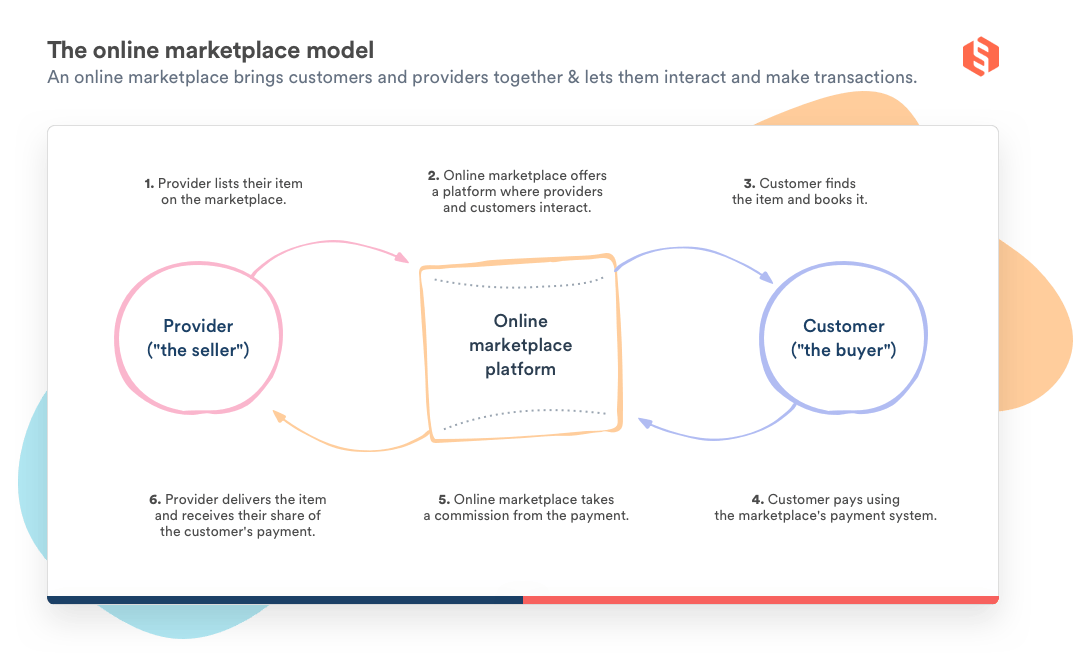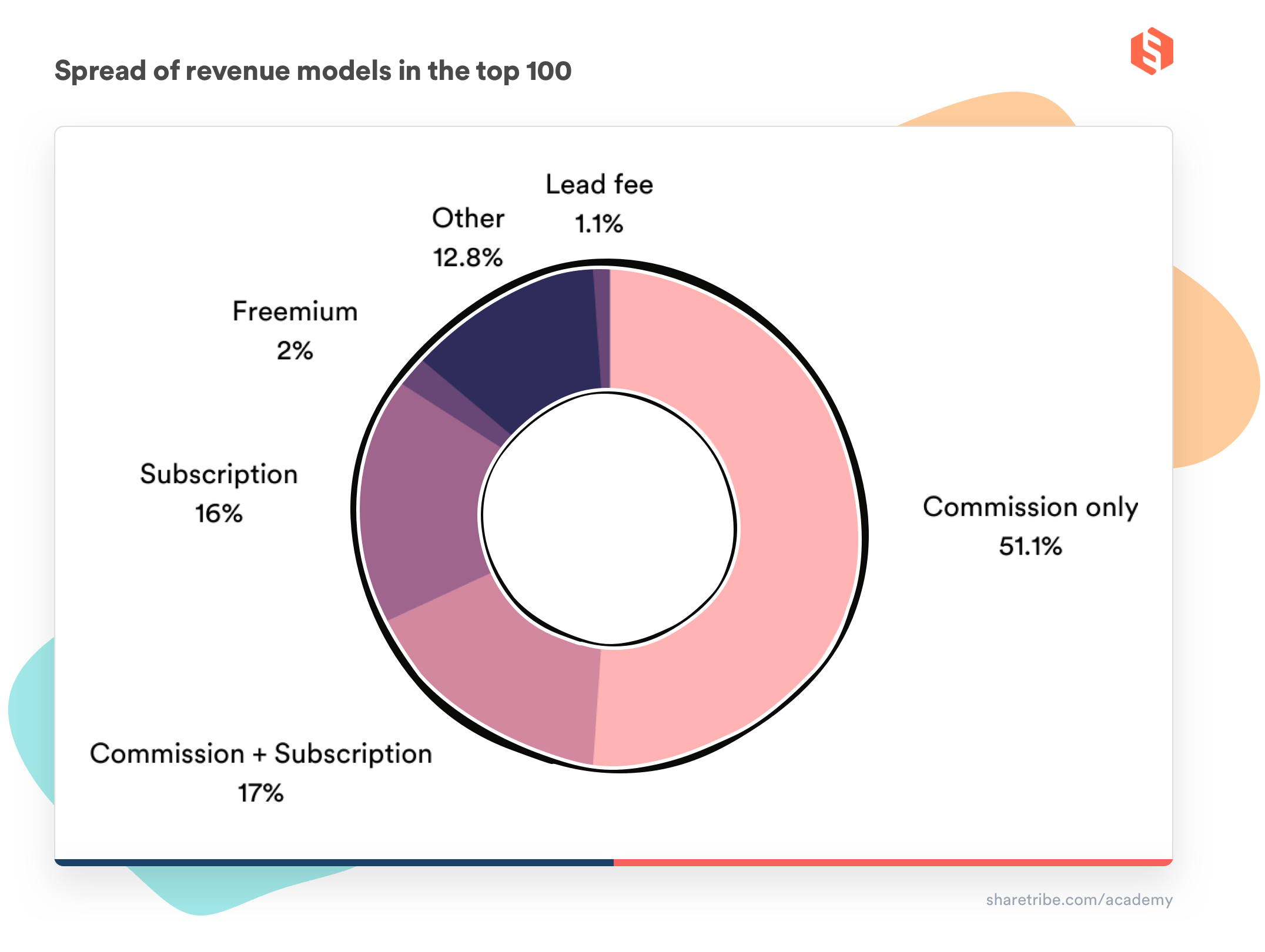The marketplace business model guide
Learn how the marketplace model works and brings benefits to all parties involved: the sellers, the buyers, and the marketplace owner.
Published on
Last updated on

We've seen this first hand at Sharetribe: marketplaces are phenomenal businesses.
A marketplace can make buying and selling anything faster, easier, more convenient, and more affordable than any traditional solution. This brings powerful benefits to all parties involved: the buyers, the sellers—and the marketplace owner.
Here's a guide to how the marketplace model works, what ways to monetize a marketplace exist, and how to choose the right revenue strategy for your business. We'll cover:
- What is the marketplace model
- Benefits of the marketplace model
- Challenges of the model (and how to overcome them)
- The six business models marketplaces use to monetize
- Commission model (and why it's the most popular marketplace business model)
- Membership fee or subscription fee
- Listing fee
- Lead fee
- Freemium
- Featured listings and ads.
This guide is also available in audio and video.
This video is the second step in our ten-step marketplace course. Here's the full video course on building a marketplace.
An online marketplace is a type of eCommerce platform that connects multiple buyers and sellers. The marketplace offers a platform where the two sides can interact and tools to facilitate transactions between the two parties.
Airbnb, Etsy, Upwork, and Uber are all successful examples of businesses operating with the marketplace model.
Marketplace platforms typically don't own their own inventory: Airbnb doesn't own hotels or apartments, and Upwork doesn't have hundreds of thousands of talent on its payroll. Instead, they make money by helping buyers and sellers meet and transact.
The marketplace business model (sometimes called the marketplace pricing model or the marketplace revenue model) is how the marketplace platform makes money by matching supply and demand.
Most marketplaces monetize this dynamic by charging a commission from every payment on the platform.

Commission is likely the best candidate for your first business model as well—more on that a bit later.
A successful marketplace benefits all three parties involved: the buyers, the sellers, and the marketplace founder.
For buyers, a marketplace can significantly improve the buying experience.
- Ease. Marketplaces make it easy for customers to find exactly what they need and pay for it online.
- Selection. Marketplaces aggregate a wide selection of supply. A customer can filter, browse, and compare sellers to find the best option for them.
- Affordability. A large pool of sellers increases competition and can make it easier to find options at a suitable price point.
For sellers, a marketplace can help with running and growing their business.
- Access to customers. A key value for sellers is that a marketplace brings them more business they'd get on their own. For example, marketplaces can have stronger search engine visibility than individual sellers would get for their own websites.
- Tools to manage bookings and online payments. A marketplace's payment system offers a reliable way to ensure a seller is paid. For professional sellers, managing availability or inventory, bookings, and cancellations can be a huge benefit.
- Help and insights to grow sales. The community of other sellers can be a source of help and peer support. Many marketplaces put a lot of effort into creating educational content, meetups, and webinars that help their sellers succeed on the platform.
For the founder, the marketplace model has tremendous benefits over more traditional business models:
- Low initial costs and risk. You don't need to invest in owning your inventory, because your supply creates it for you.
- Easy to launch, run, and scale. An online marketplace is a complicated website. Thanks to marketplace software (like ours at Sharetribe), you can launch a fully functional marketplace at a fraction of the time and cost it would take to build one from scratch.
- Scalability. Entering new markets requires lower upfront investment than traditional businesses because a marketplace needs less local infrastructure upfront. And, as you'll learn later in this article, commission is a scalable business model that creates minimal friction for users.
- Network effects. Two-sided businesses like marketplaces can benefit from a unique growth dynamic where each new user increases the value of the business. Network effects create defensible businesses that are harder to disrupt.
The marketplace model has unique benefits, but also some challenges that traditional eCommerce businesses don't face.
- Chicken and egg problem. A marketplace connects sellers and buyers. The value of the marketplace for one side is the other side being present. So, how do you bring in your very first users? For most marketplaces, the right strategy is to first build supply. Here's an article with over 30 examples of how successful marketplaces have solved the chicken and egg problem.
- Reaching liquidity. Many founders think marketplaces need a huge number of users to succeed. In reality, a small number of initial users is enough, so long as the supply and demand are well-matched. This is measured by liquidity. Here's our thorough article on how to measure and improve liquidity on your marketplace.
- Platform leakage. If your users feel like your marketplace fees are higher than the value you provide, they might use your platform to connect but make payments outside of your payment system. Here's our article on preventing platform leakage.
A key decision that can help or hamper solving these challenges is choosing the right monetization strategy. Next, I'll introduce the six ways to monetize a marketplace and discuss why commission is likely the strongest, most scalable revenue model for your marketplace.
There are many reasons to start a marketplace: making the world a better place, achieving financial independence, becoming rich… But one thing is true across the board. To run a business, you’re going to need a sustainable revenue model to finance its operations.
One of the most common reasons why startups fail is that they pick a business model that does not scale.
At Sharetribe, we studied how the top one hundred marketplaces in the world monetize. We found that they use either one or several of these six marketplace business models (sometimes also called "marketplace pricing models":
- Commission
- Membership/subscription fee
- Listing fee
- Lead fee
- Freemium
- Featured listings and ads
Commission is by far the most widely used, and for a good reason. In fact, we found that the other business models are most often used as complimentary revenue streams on top of the commission model.
Commission, also known as transaction fee, take rate, or rake, is the percentage or flat fee that a marketplace charges from a transaction.
Commission is by far the most commonly used marketplace revenue model. The best-known marketplace platforms—like Airbnb, Etsy, eBay, Fiverr, TaskRabbit, and Uber—all use commissions as their main revenue stream. In Sharetribe's study of the top 100 marketplaces, over half of the top platforms monetize by commission only. Of the rest, a third uses commission in combination with another revenue model like subscriptions.

The commission model is so popular because of two key things:
- It’s great for users. They only pay you when they get value themselves. Before that, using the platform is free.
- From the platform’s point of view, it’s usually the most lucrative option. You get a piece of all GMV (the total monetary value of all the products or services sold through your marketplace) that passes through your platform. And as you grow, your commission profits do too.
However, the model comes with two key challenges:
- Providing enough value for both the customer and the provider. If your users do not get enough value from your platform, they will find a way to go around your payment system, and you will not get paid. The amount of value you need to provide to keep users willing to pay your commission is directly related to the second challenge:
- Finding the right pricing level. How big should the commission be? Should it be the same for all users? Should you charge the customer, the provider, or both? Should you first have a lower commission to get people to join my platform and raise it later? It's easy to think that you should set your take rate as high as possible, but it's important not to introduce artificial friction to your platform through excessively high rates.
Chapters 4 and 5 of this guide provide lots of advice on solving these two challenges: How to discourage platform leakage and How to set pricing on your marketplace.
My recommendation for every marketplace founder is to use commission as your main revenue stream whenever feasible.
In by far the most cases, commission is the most lucrative and scalable model that creates the least friction for new users to sign up.
There are, however, scenarios in which it is not feasible for the platform to facilitate payment transactions. Here are examples of cases where the commission model doesn't work:
- When the size of the typical transaction is huge. With car or real estate sales, for instance, it's difficult for the marketplace to justify the commission.
- The marketplace has lots of different types of offerings. It becomes impossible to design a transaction process that provides value for all of those cases. Traditional classified ads are a good example of this.
- The invoicing process is too complex for the marketplace to facilitate. This is common in business-to-business (B2B) and some business-to-consumer (B2C) marketplaces.
- Money is not exchanged at all on the platform. For instance, if the marketplace is about dating, finding people to hire, bartering, or sharing something for free, there's no monetary transaction involved and thus no way to charge a commission.
In these cases, you need a different type of marketplace business model.
A membership fee (sometimes called a subscription fee) is a marketplace business model where either some or all of a marketplace's users are charged a recurring fee to access the marketplace.
With this revenue strategy, the typical value proposition for providers is that the platform helps them find new customers. For customers, it helps them save costs or find unique experiences.
The membership fee is a good choice if the value you provide is high and a typical user will engage in several transactions, but facilitating payments is challenging or impossible. It's not unocommon for a marketplace to switch from commission to a combined commission + subscription fee model, or even subscription fees alone, once their user base is strong and they are continuously creating value to users.
The challenge with the membership fee model is that it makes the "chicken and egg problem"—how to find sellers without customers and how to find customers without sellers—even worse. You need to have enough users on your platform to make it valuable for both sellers and customers, and a mandatory payment discourages users from signing up.
One way to get around this is to offer heavy discounts for early adopters, or even lift the fee completely to build the initial user base.
Typical examples of marketplaces that succeed on the subscription fee model are
- Consumer-to-consumer (C2C) marketplaces like home-swapping sites (Love Home Swap, Home Exchange) and dating sites (OkCupid, Match.com). Oftentimes, these sites vet all the subscribers to guarantee quality matches and create a sense of exclusivity that justifies the fee.
- B2C market recruiting marketplaces. For instance, LinkedIn and StackOverflow charge companies a subscription fee to get access to their talent pools. With B2C companies, the platform is typically free for customers but requires a paid subscription for providers.
- A membership fee can also be a good initial revenue stream for B2C marketplaces that eventually want to charge a commission but don't yet have the tools in place to facilitate transactions in their particular niche. Venuu, an "Airbnb for event spaces", started with memberships to get revenue upfront, even before launching their site. Later on, when they had validated their business plan and had the resources to build an invoicing system, they moved to the commission model—a revenue model that was much more lucrative for them.
Some marketplaces charge a fee from sellers when they post new listings. This marketplace business model is typically used when sellers get value based on the number of listings they have on the site, and the potential value per listing is big.
A listing fee is better than a membership fee in cases where sellers don't want a continuous subscription and only want to sell certain items.
The challenge with listing fees is that they don't guarantee value for sellers, so the fee can't be too high. This means the platform can capture only a relatively small portion of the value going through the site.
A sustainable business model that depends solely on listing fees thus requires a very large volume of listings. Additionally, since paying a listing fee does not guarantee that the item is sold, the marketplace will have a harder time proving that it provides actual value to the sellers.
- C2C classifieds marketplaces. On classifieds sites, the value proposition of the website is really simple: it aggregates a massive volume of listings to a single online destination and guarantees lots of visibility for those listings. Classified ad platforms typically don't even try to facilitate the transaction. Perhaps the most well-known example in this category is Craigslist. Generally, posting a new listing to Craigslist is free—this is how they managed to reach critical user mass—but in certain categories (namely, job and apartment listings in some cities), they charge a fee for each listing.
- B2B classifieds marketplaces. For example, Mascus, a B2B classifieds site for expensive machinery, also monetizes through listing fees.
- Many types of marketplace in combination with other business models. For instance, Etsy is a B2C marketplace that uses commissions but also charges a fee to post new listings. Etsy's reasoning for this is likely that its liquidity (the probability of a certain item being sold) varies a lot. While there are some hugely popular items on Etsy, most items probably never get a single sale because Etsy's total volume of listings is massive. By using both commission and listing fees, Etsy gets revenue from both popular and not-so-popular items.
Lead fees are somewhere between the listing fee and commissions. In a typical lead fee model, customers post requests on the site, and providers pay to make a bid for these customers.
Lead fees offer a better value proposition than listing fees: you only pay when you are connected with a potential customer.
Lead fees only work if the lead's value is high. For this reason, this model isn't common in C2C marketplaces.
A typical use case is B2C or B2B services, where each new lead can result in a long-lasting customer relationship with multiple deals. A recent well-performing example of this model is Thumbtack, a B2C marketplace for all kinds of local professional services, from plumbers to guitar teachers. In 2021, the company was valued at more than $3 billion.
However, Thumbtack is a bit of an anomaly among service marketplaces. By far the most successful marketplaces in its niche monetize through commission.
While Thumbtack has been doing well with lead fees so far, their problem is that the providers no longer use Thumbtack with existing customers—instead, they build the relationship outside the platform once they have the lead. This is why Thumbtack decided to build invoicing, payment, and scheduling tools for professionals.
How can you monetize a marketplace where people share low-value items for free?
The Dutch startup Peerby has built a C2C platform where people can borrow things from each other at no cost. The basic experience is free for all the users of the platform.
Peerby has decided to monetize by offering premium services. They have two main offerings: insurance (the provider can request that the customer, while getting the item for free, pays an insurance fee that guarantees the item will be replaced if it is damaged or stolen) and delivery (the customer can pay a small fee to get the item delivered to their door instead of having to go pick it up from the provider).
The logic behind the freemium model is that the core offering is free, but after you get your users hooked, you offer paid value-adding features.
The challenge is that these paid services need to provide enough value to be tempting to a good portion of your users. If only 1% of your users are interested in your premium offering and everyone else uses your site for free, it's probably not enough to be a sustainable revenue stream.
Coming up with a premium service that is interesting for a wide enough audience can be very tricky. Because of this, many platforms use premium services as additional revenue streams.
- For example, Mascus offers premium web page services to its customers to complement its listing-fee-based marketplace business model.
- Etsy complements its transaction and listing fees by offering premium services like direct checkout, listing promotion, and shipping labels to its power sellers and has recently seen strong growth from this revenue stream.
- In some cases, a marketplace can start offering premium services as an add-on but eventually shift its entire business strategy to focus on paid services. Vayable started as a pure peer-to-peer marketplace where individual people offer unique experiences to others, but after failing to get enough traction, it decided to pivot to build a concierge service for custom vacations. The downside of this approach is that premium services are often a less scalable option when compared to pure commissions. This is often due to the amount of staff that is required to provide the premium services. Vayable only made the shift because they were not able to get commissions to work well enough.
Featured listings are a way for sellers to buy more visibility for their offerings. Listing on the site is typically free, but sellers can pay to have their listing featured on the homepage of the site or at the top of a certain category.
As a marketplace business model, featured listings and ads are relatively close to pure advertising, where you show ads (such as Google AdSense) to your users.
The challenge with these models is that, again, they require a significant amount of users to generate meaningful revenue. When you're in the business of selling eyeballs, the revenue you generate per user is likely a lot less than if you can extract value from your transaction process.
Moreover, when you place ads on your site, you're serving two audiences with conflicting interests: from a user experience point of view, ads are almost always a hindrance, and your users would generally be happier without ads. If you want to offer the best possible experience for your users, featured listings and ads are not your best option.
Featured listings and ads are commonly seen on:
- Classified ad sites. For example, Gumtree, UK's most popular classified ads website, uses this model.
- Free sharing platforms (e.g. Freecycle).
- Real estate marketplaces (like Zillow) often have featured listings.
- Marketplaces targeting a really specific niche. For instance, Häätori, a Finnish wedding marketplace for used wedding dresses, lets individuals use the site for free. They monetize by allowing wedding planners, photographers, and other providers of wedding-related services to buy ads on the site. The content of these ads is very relevant for the users of the website, making them less annoying.
- On marketplaces like Etsy one of their premium services.
Modern marketplaces employ many different revenue strategies. In general, the best business model for most is to "own the transaction" and charge a commission from all purchases made through the site. This approach is very scalable and oftentimes quite lucrative.
However, in some cases, commissions don't make sense, so alternative models are needed. Trying out multiple business models to find the best option for your concept might be a good idea.
In the beginning, you should have only one revenue stream in use at a time to avoid diverting your focus. Eventually, when your platform grows, it might make sense to combine several revenue streams to take everything that is happening on your site into account.
You might also like...

How to prevent marketplace leakage (and keep payments on your platform)
How to solve the most daunting challenge of the marketplace business model: platform leakage.

Marketplace pricing: How to set the right take rate
The right marketplace pricing level depends on many different factors internal or external to your marketplace. Here's what you should consider to find the optimal pricing level for your marketplace.

Marketplace software: How to compare and choose the best solution
There are dozens of online marketplace software alternatives to choose from. Learn how to make the right choice for your marketplace idea.
Start your 14-day free trial
Create a marketplace today!
- Launch quickly, without coding
- Extend infinitely
- Scale to any size
No credit card required
